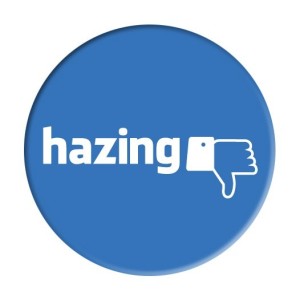Note: Will Overstreet is a former captain of the University of Tennessee football team and was drafted in the third round by the NFL’s Atlanta Falcons in 2002.
By Will Overstreet {grow} Community Member
The recent headline story about the hazing of a Miami Dolphins player hit home for me as I considered my own experience with hazing and my fears about these behaviors on the social web. Is hazing harmful, or a rite of passage? How does social media make bullying worse? Is there a solution?
 I can almost guarantee that my coaches, teammates, and fans would not know that after my freshman year of college — where I had played extensively and had been part of a national championship team — I contemplated not returning to the team after the winter break. In fact, I had a long discussion with my parents about transferring due an unrelenting hazing hell.
I can almost guarantee that my coaches, teammates, and fans would not know that after my freshman year of college — where I had played extensively and had been part of a national championship team — I contemplated not returning to the team after the winter break. In fact, I had a long discussion with my parents about transferring due an unrelenting hazing hell.
One senior on the team made it his job to haze me my whole first year. I dreaded every practice and meeting because not only would he attack me, but he also actively recruited others to participate too.
It was so bad that when my birthday rolled around I went out of my way to try to hide that fact because I knew there would be ramifications if anyone found out. Sure enough, at the end of the practice seven players cornered me and taped me to my locker. I laugh when I think back on it today, but at the time it was one more of a thousand cuts. In isolation, these jokes and pranks would not be cause for concern, but sustained for months on end, hazing became demoralizing. I think it would be that way for anyone.
You might wonder, “Why didn’t I go to anyone for help?”
I didn’t reach out for the same reason many others don’t — we are raised with the mentality (or overhear the advice of others) to, “Toughen up.” The rationale is that bullying is a part of life and a tradition for many organizations like football locker rooms and fraternities. Another group of people go so far as to say hazing is nothing more than friendly banter and can actually be used to improve the individual because it will make them mentally tougher. What this reasoning actually does is exacerbate the pain of the individual and only reinforces their silence.
The cumulative effects of hazing
What I experienced reminds me of the characters in Lord of the Flies. In this beloved book, we read the story about a group of boys stranded on a deserted island that slowly devolve into warring tribes that prey upon the weaker members of their party. This transformation starts with what most people would only classify as schoolyard antics.
This is not just fiction. One of the most famous demonstrations of the psychology of hazing is the 1971 Stanford Prison Experiment. The experiment took everyday people and divided them into two groups: “prisoners” and “guards.” The guards were given free reign to enforce their will upon the prisoners. The experiment had to be stopped after only three days because the guards were becoming increasingly more aggressive and the administrators of the experiment began fearing for the lives of the “prisoners.” To say hazing is harmless and does no real damage to the victim is at best willful ignorance of human nature. Tolerating any form of hazing will ultimately lead to increasingly cruel behavior
Social media amplifies bullying
What makes this even more dangerous today is we are all connected through our mobile phones and social media 24 hours a day. This means that our homes are no longer safe havens for those being bullied — social media proves to be highly effective in making bullying easier and its damage more long-lasting. Here are a few of my reasons for saying this:
Repetition – Chinese water torture is not effective because of one drop of water. It is effective as a form of torture because of the unrelenting repetition of drop after drop hitting the victim on the head for a sustained period of time. Social media gives cyber bullies the ability to quickly and easily sustain their attack without ever leaving their home. After enough time, the victim’s insecurities take hold and corrode the individual from the inside out.
Building a Pack – In the Lord of the Flies, a deserted island was the setting needed to free the boys from oversight of authority figures, so that they could easily form together to root out and destroy the weaker/Piggie’s of their social realm. Facebook and Twitter provide this same type of unregulated arena that not only allows bullies to find friends and band together, but also allows for these same individuals to create fake persona’s to perform a seemingly multi person attack.
It’s Public – Not only can the victim not escape the attack but there also isn’t a way to separate the different social circles that make up their life. All past, present, and future connections will be able to see what the bullies have claimed.
Class System – In the Stanford experiment a necessary first step for creating a hostile environment was to rank victims as a lower class. Once the victim is placed in a lower class the bully can remove any thoughts of remorse or pity for their actions and future consequences from their actions. On football teams, the class system comes ready made with freshmen and rookies being in the lower tier. I think we all can remember the terms with which high school teenagers use to label those that do not fit in.
Impersonal – Cyber bullies are more intense in their attacks on social media due to the lack of human interaction. The computer screen cannot show the reaction of the individual as they read a remark and the victim can’t punch the individual saying the remark. In essence the attacker is secure and free from any consequences or connection to their victim’s pain.
Is there a solution?
Unfortunately, there are no easy answers. The only real way I believe to win the war against bullying is to adhere to the words of Edmund Burke: “The only thing necessary for the triumph of evil is for good men to do nothing.”
We need to set about teaching individuals how to be heroes and then promote those that do come to the defense of others. This will not only help reinforce the ideals we hope to instill in everyone, but will also allow us to incentivize individuals to take action.
The final, and most important, thing we can do is encourage dialogue, making clear that the person should tell us if they are in need and assure them we will not provide them the same old misguided advice of “You just need to toughen up.”
The responsibility should not be the victims to bear alone, but is for all of us to take a stand. One day our best friend or child might be in a state of emotional distress and thinking of harming themselves. What advice would we want them to receive, because at the end of day: “No man is an Iland, intire of it selfe; every man is a piece of the Continent, a part of the main.” — John Donne
 Will Overstreet is the founder of Voices Heard Media, a company creating new interactive web experiences. Follow him on Twitter and his blog.
Will Overstreet is the founder of Voices Heard Media, a company creating new interactive web experiences. Follow him on Twitter and his blog.



